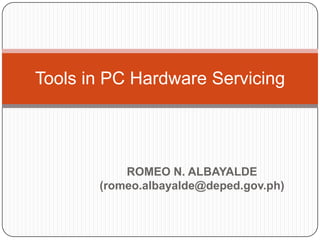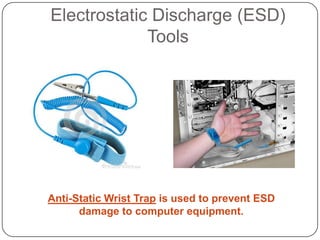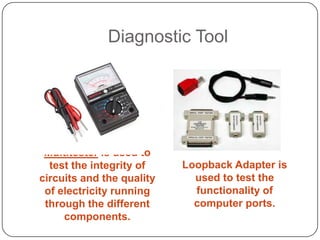Tools in pc hardware servicing
- 1. ROMEO N. ALBAYALDE (romeo.albayalde@deped.gov.ph) Tools in PC Hardware Servicing
- 2. Electrostatic Discharge (ESD) Tools Anti-Static Wrist Trap is used to prevent ESD damage to computer equipment.
- 3. Electrostatic Discharge (ESD) Tools Anti-Static Mat is used to stand on or place hardware on to prevent static electricity from building up.
- 4. Hand Tools Flat Head Screwdriver is used to tighten or loosen screws with slotted heads. Philips Screwdriver is used to tighten or loosen screws with cross-heads.
- 5. Hand Tools Torx Screwdriver is used to loosen or tighten screws with star-like depression on its head. This feature is mainly found on laptops. Hex Driver is used to loosen or tighten nuts in the same way that a screwdriver tighten screws. It sis also called nut driver.
- 6. Hand Tools Needle-Nose Plier is used to hold small parts. It is also used to bend, re-position, and cut wires. Wire Cutter is used to strip and cut wires.
- 7. Hand Tools Tweezers is used to manipulate small parts. Part Retriever is used to retrieve parts from locations that is to small for your hand to fit.
- 8. Hand Tools Flashlight is used to light up areas in the system unit that you can not see well.
- 9. Cleaning Tools Lint-free Cloth is used to clean different computer parts without scratching or leaving debris. Compressed Air is used to blow away dust and debris from computer parts without touching the components.
- 10. Cleaning Tools Cable Ties are used to bundle cables neatly inside and outside the system unit. Parts Organizer is used to hold screws, jumpers, fasteners and other small parts and prevents them from getting mixed together.
- 11. Diagnostic Tool Multitester is used to test the integrity of circuits and the quality of electricity running through the different components. Loopback Adapter is used to test the functionality of computer ports.
- 12. THANK YOU












